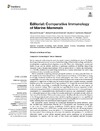Please use this identifier to cite or link to this item:
https://accedacris.ulpgc.es/jspui/handle/10553/70039
| DC Field | Value | Language |
|---|---|---|
| dc.contributor.author | Di Guardo, Giovanni | - |
| dc.contributor.author | Criscitiello, Michael Frederick | - |
| dc.contributor.author | Sierra Pulpillo, Eva María | - |
| dc.contributor.author | Mazzariol, Sandro | - |
| dc.date.accessioned | 2020-02-05T12:52:03Z | - |
| dc.date.accessioned | 2020-06-08T14:03:51Z | - |
| dc.date.available | 2020-02-05T12:52:03Z | - |
| dc.date.available | 2020-06-08T14:03:51Z | - |
| dc.date.issued | 2019 | - |
| dc.identifier.issn | 1664-3224 | - |
| dc.identifier.other | Scopus | - |
| dc.identifier.uri | https://accedacris.ulpgc.es/handle/10553/70039 | - |
| dc.description.abstract | Marine mammals rank among the most charismatic creatures inhabiting our planet. Yet despite their long evolutionary history, we have a limited knowledge of their biology, ecology, and behavior, including their morphofunctional adaptations to sea life. This is also frustrating for translational studies, as gas and fat embolic syndrome, a pathologic condition of Ziphiidae (deep-diving cetaceans), mimics decompression sickness (DCS) in human divers (1). Indeed, the development of a DCS-like condition in animals living exclusively in a marine environment for such a long evolutionary history was totally unpredictable! | - |
| dc.language | eng | - |
| dc.relation.ispartof | Frontiers in Immunology | - |
| dc.source | Frontiers In Immunology [ISSN 1664-3224], v. 10, (Octubre 2019) | - |
| dc.subject | 3105 Peces y fauna silvestre | - |
| dc.subject | 310903 Inmunología | - |
| dc.subject.other | Acquired Immunity | - |
| dc.subject.other | Cetaceans | - |
| dc.subject.other | Comparative Immunology | - |
| dc.subject.other | Host | - |
| dc.subject.other | Immunotoxic Contaminants | - |
| dc.subject.other | Innate Immunity | - |
| dc.subject.other | Marine Mammals | - |
| dc.subject.other | Pathogen Interaction | - |
| dc.subject.other | Pinnipeds | - |
| dc.title | Editorial: Comparative immunology of marine mammals | - |
| dc.type | info:eu-repo/semantics/article | - |
| dc.type | Article | - |
| dc.identifier.doi | 10.3389/fimmu.2019.02300 | - |
| dc.identifier.scopus | 85073230586 | - |
| dc.identifier.isi | 000496969300001 | - |
| dc.contributor.authorscopusid | 36860870100 | - |
| dc.contributor.authorscopusid | 6603909821 | - |
| dc.contributor.authorscopusid | 15742962600 | - |
| dc.contributor.authorscopusid | 24173815500 | - |
| dc.relation.volume | 10 | - |
| dc.investigacion | Ciencias de la Salud | - |
| dc.type2 | Comentario | - |
| dc.contributor.daisngid | 364862 | - |
| dc.contributor.daisngid | 29895782 | - |
| dc.contributor.daisngid | 30396242 | - |
| dc.contributor.daisngid | 888516 | - |
| dc.description.numberofpages | 3 | - |
| dc.utils.revision | Sí | - |
| dc.contributor.wosstandard | WOS:Di Guardo, G | - |
| dc.contributor.wosstandard | WOS:Criscitiello, MF | - |
| dc.contributor.wosstandard | WOS:Sierra, E | - |
| dc.contributor.wosstandard | WOS:Mazzariol, S | - |
| dc.date.coverdate | Octubre 2019 | - |
| dc.identifier.ulpgc | Sí | - |
| dc.contributor.buulpgc | BU-VET | - |
| dc.description.sjr | 2,116 | - |
| dc.description.jcr | 5,085 | - |
| dc.description.sjrq | Q1 | - |
| dc.description.jcrq | Q1 | - |
| dc.description.scie | SCIE | - |
| item.grantfulltext | open | - |
| item.fulltext | Con texto completo | - |
| crisitem.author.dept | GIR IUSA-ONEHEALTH 3: Histología y Patología Veterinaria y Forense (Terrestre y Marina) | - |
| crisitem.author.dept | IU de Sanidad Animal y Seguridad Alimentaria | - |
| crisitem.author.dept | Departamento de Morfología | - |
| crisitem.author.orcid | 0000-0003-3749-8845 | - |
| crisitem.author.parentorg | IU de Sanidad Animal y Seguridad Alimentaria | - |
| crisitem.author.fullName | Sierra Pulpillo, Eva María | - |
| Appears in Collections: | Comentario | |
SCOPUSTM
Citations
6
checked on Jun 8, 2025
WEB OF SCIENCETM
Citations
6
checked on Jun 8, 2025
Page view(s)
110
checked on Mar 1, 2025
Download(s)
110
checked on Mar 1, 2025
Google ScholarTM
Check
Altmetric
Share
Export metadata
Items in accedaCRIS are protected by copyright, with all rights reserved, unless otherwise indicated.
